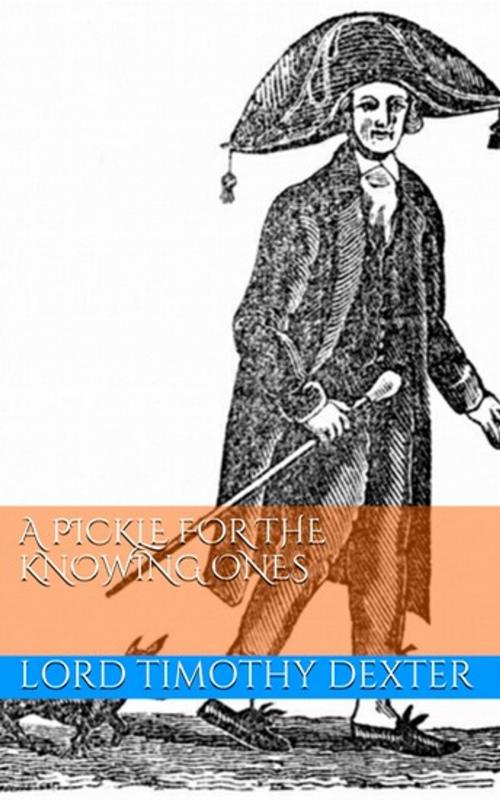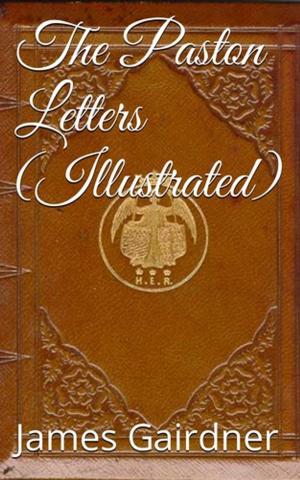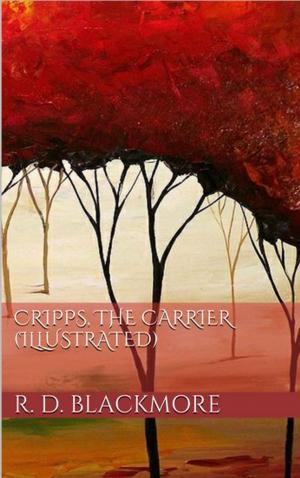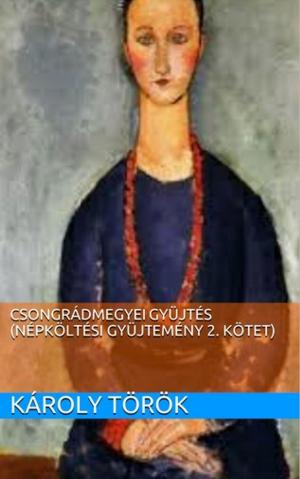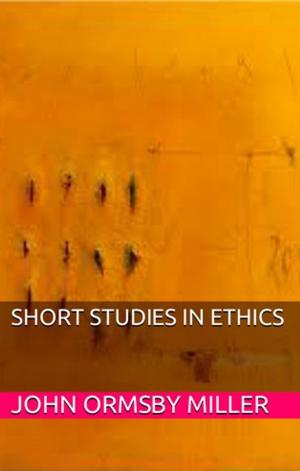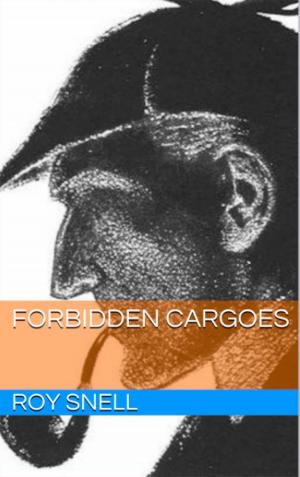| Author: | Lord Timothy Dexter | ISBN: | 1230000159703 |
| Publisher: | Lost Leaf Publications | Publication: | August 13, 2013 |
| Imprint: | Language: | English |
| Author: | Lord Timothy Dexter |
| ISBN: | 1230000159703 |
| Publisher: | Lost Leaf Publications |
| Publication: | August 13, 2013 |
| Imprint: | |
| Language: | English |
PREFACE.
Timothy Dexter, the author of the following curious and unique production, entitled "A Pickle for the Knowing Ones," which is here re-printed verbatim et spellatim from the original edition, was born in Malden, January 22, 1747. Having served an apprenticeship with a leather dresser, he commenced business in Newburyport shortly after he was one and twenty, and being industrious and economical, he soon found himself in good circumstances. In the year 1770 he married, and receiving a considerable amount of money with his wife, he was thus put in possession of a moderate fortune. In 1776 he had for one of his apprentices the no less eccentric, and afterwards the no less noted Jonathan Plumer, jun., "travelling preacher, physician and poet," as he was accustomed to style himself, and of whom we shall hereafter speak. In addition to his regular business of selling leather breeches, gloves "soutabel for wimen's ware," &c. he engaged in commercial speculations, and in various kinds of business, and was unusually successful. He traded with merchants and speculators in the then Province of Maine, was engaged to some extent in the West India trade. He also purchased a large amount of what were called State securities, which were eventually redeemed at prices far exceeding their original cost. Some of his speculations in whalebone and warming pans are mentioned by himself on page 23 of this work. Thus in various ways he added to his property, and in a few years he became a wealthy man. With wealth came the desire of distinction, and as his vanity was inordinate he spared no expence in obtaining the notoriety he sought. In the first place he purchased an elegant house in High Street, Newburyport, and embellished it in his peculiar way. Minarets surmounted with golden balls were placed on the roof, a large gilt eagle was placed on the top, and a great variety of other ornaments. In front of his house and land he caused to be erected between forty and fifty wooden statues, full length and larger than life. The principal arch stood directly in front of his door, and on this stood the figures of Washington, Adams and Jefferson. There were also the statues of William Pitt, Franklin, Bonaparte, George IV, Lord Nelson, Gen. Morgan, Cornplanter, an Indian Chief, Jack Tar, Traveling Preacher, Maternal Affection, Two Grenadiers, Four Lions and one Lamb, and conspicuous among them were two images of Dexter himself, one of which held a label with the inscription "I am the first in the East, the first in the West, and the greatest philosopher in the Western world." In order that the interior of his house should correspond with the exterior, the most costly furniture was imported from France, and the walls hung with paintings, brought from Holland and other parts of Europe. A library was also provided, but how large or valuable we are not able to say. An elegant coach with a span of beautiful cream colored horses was procured, on which was painted his coat of arms, with the baronial supporters, after the manner of the English nobility. With this equipage he took the title of Lord Dexter, because, as he said, it was "the voice of the people at Large." He was sometimes called the Marquis of Newburyport. Having completed the embelishments of his house and gardens, Lord Dexter busied himself in receiving the visits of the crowds, who were drawn by curiosity to his house. His gardens were thrown open to their inspection, and he was liberal to all. The fame of his hospitality attracted as many visitors as the fame of his images. To gratify his vanity he selected in imitation of European princes, a poet laureate. This was no other than his former apprentice, Jonathan Plumer, jun., a native of Newbury. [4] They had once been associated as master and apprentice, but now stood in the relation of patron and poet.
PREFACE.
Timothy Dexter, the author of the following curious and unique production, entitled "A Pickle for the Knowing Ones," which is here re-printed verbatim et spellatim from the original edition, was born in Malden, January 22, 1747. Having served an apprenticeship with a leather dresser, he commenced business in Newburyport shortly after he was one and twenty, and being industrious and economical, he soon found himself in good circumstances. In the year 1770 he married, and receiving a considerable amount of money with his wife, he was thus put in possession of a moderate fortune. In 1776 he had for one of his apprentices the no less eccentric, and afterwards the no less noted Jonathan Plumer, jun., "travelling preacher, physician and poet," as he was accustomed to style himself, and of whom we shall hereafter speak. In addition to his regular business of selling leather breeches, gloves "soutabel for wimen's ware," &c. he engaged in commercial speculations, and in various kinds of business, and was unusually successful. He traded with merchants and speculators in the then Province of Maine, was engaged to some extent in the West India trade. He also purchased a large amount of what were called State securities, which were eventually redeemed at prices far exceeding their original cost. Some of his speculations in whalebone and warming pans are mentioned by himself on page 23 of this work. Thus in various ways he added to his property, and in a few years he became a wealthy man. With wealth came the desire of distinction, and as his vanity was inordinate he spared no expence in obtaining the notoriety he sought. In the first place he purchased an elegant house in High Street, Newburyport, and embellished it in his peculiar way. Minarets surmounted with golden balls were placed on the roof, a large gilt eagle was placed on the top, and a great variety of other ornaments. In front of his house and land he caused to be erected between forty and fifty wooden statues, full length and larger than life. The principal arch stood directly in front of his door, and on this stood the figures of Washington, Adams and Jefferson. There were also the statues of William Pitt, Franklin, Bonaparte, George IV, Lord Nelson, Gen. Morgan, Cornplanter, an Indian Chief, Jack Tar, Traveling Preacher, Maternal Affection, Two Grenadiers, Four Lions and one Lamb, and conspicuous among them were two images of Dexter himself, one of which held a label with the inscription "I am the first in the East, the first in the West, and the greatest philosopher in the Western world." In order that the interior of his house should correspond with the exterior, the most costly furniture was imported from France, and the walls hung with paintings, brought from Holland and other parts of Europe. A library was also provided, but how large or valuable we are not able to say. An elegant coach with a span of beautiful cream colored horses was procured, on which was painted his coat of arms, with the baronial supporters, after the manner of the English nobility. With this equipage he took the title of Lord Dexter, because, as he said, it was "the voice of the people at Large." He was sometimes called the Marquis of Newburyport. Having completed the embelishments of his house and gardens, Lord Dexter busied himself in receiving the visits of the crowds, who were drawn by curiosity to his house. His gardens were thrown open to their inspection, and he was liberal to all. The fame of his hospitality attracted as many visitors as the fame of his images. To gratify his vanity he selected in imitation of European princes, a poet laureate. This was no other than his former apprentice, Jonathan Plumer, jun., a native of Newbury. [4] They had once been associated as master and apprentice, but now stood in the relation of patron and poet.
